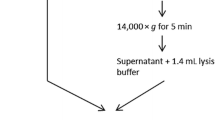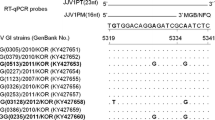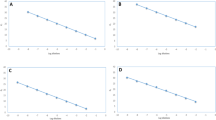Abstract
Human noroviruses (HuNoVs) are highly infectious viruses for which water is an important medium of transmission. In this study, we explored a new in situ capture RT-qPCR (ISC-RT-qPCR) methodology to estimate the infectivity of HuNoV in environmental water samples. This assay was based on capturing encapsidated HuNoV by viral receptors, followed by in situ amplification of the captured viral genomes by RT-qPCR. We demonstrated that the ISC-RT-qPCR did not capture and enable signal amplification of heat-denatured Tulane Virus (TV) and HuNoVs. We further demonstrated that the sensitivity of ISC-RT-qPCR was equal or better than that of conventional RT-qPCR procedures for the detection of HuNoV GI and GII. We then utilized the ISC-RT-qPCR to detect HuNoV in environmental water samples for comparison against that from a conventional RT-qPCR procedure. TV was used as a process control virus. While complete inhibition of TV genomic signal was observed in 27% of samples tested by RT-qPCR, no inhibition of TV genomic signal was observed by ISC-RT-qPCR. From 72 samples tested positive for HuNoV GI signal by RT-qPCR, only 20 (27.8%) of these samples tested positive by ISC-RT-qPCR, suggesting that 72.2% of RT-qPCR-positive samples were unlikely to be infectious. From 16 samples tested positive for HuNoV GII signal by RT-qPCR, only one of these samples tested positive by ISC-RT-qPCR. Five samples that had initially tested negative for HuNoV GII signal by RT-qPCR, was tested as positive by ISC-RT-qPCR. Overall, ISC-RT-qPCR method provided an alternative assay to estimate infectivity of HuNoV in environmental samples.
Similar content being viewed by others
References
Atmar, R. L., Opekun, A. R., Gilger, M. A., Estes, M. K., Crawford, S. E., Neill, F. H., et al. (2008). Norwalk virus shedding after experimental human infection. Emerging Infectious Diseases Journal, 14(10), 1553–1557. doi:10.3201/eid1410.080117.
Baert, L., Wobus, C. E., Van Coillie, E., Thackray, L. B., Debevere, J., & Uyttendaele, M. (2008). Detection of murine norovirus 1 by using plaque assay, transfection assay, and real-time reverse transcription-PCR before and after heat exposure. Applied and Environment Microbiology, 74(2), 543–546. doi:10.1128/AEM.01039-07.
Cannon, J. L., & Vinje, J. (2008). Histo-blood group antigen assay for detecting noroviruses in water. Applied and Environmental Microbiology, 74(21), 6818–6819. doi:10.1128/AEM.01302-08.
Centers for Disease and Prevention. (2011). Surveillance for foodborne disease outbreaks–United States, 2008. MMWR Morbidity and Mortality Weekly Report, 60, 1197–1202.
Cooley, M. B., Quinones, B., Oryang, D., Mandrell, R. E., & Gorski, L. (2014). Prevalence of shiga toxin producing Escherichia coli, Salmonella enterica, and Listeria monocytogenes at public access watershed sites in a California Central Coast agricultural region. Frontiers in Cellular and Infection Microbiology, 4, 30. doi:10.3389/fcimb.2014.00030.
Corsi, S. R., Borchardt, M. A., Spencer, S. K., Hughes, P. E., & Baldwin, A. K. (2014). Human and bovine viruses in the Milwaukee River watershed: Hydrologically relevant representation and relations with environmental variables. Science of the Total Environment, 490, 849–860. doi:10.1016/j.scitotenv.2014.05.072.
Dancho, B. A., Chen, H., & Kingsley, D. H. (2012). Discrimination between infectious and non-infectious human norovirus using porcine gastric mucin. International Journal of Food Microbiology, 155(3), 222–226. doi:10.1016/j.ijfoodmicro.2012.02.010.
Ettayebi, K., Crawford, S. E., Murakami, K., Broughman, J. R., Karandikar, U., Tenge, V. R., et al. (2016). Replication of human noroviruses in stem cell-derived human enteroids. Science, 353(6306), 1387–1393. doi:10.1126/science.aaf5211.
Farkas, T., Sestak, K., Wei, C., & Jiang, X. (2008). Characterization of a rhesus monkey calicivirus representing a new genus of Caliciviridae. Journal of Virology, 82(11), 5408–5416.
Gentry, J., Vinje, J., Guadagnoli, D., & Lipp, E. K. (2009). Norovirus distribution within an estuarine environment. Applied and Environmental Microbiology, 75(17), 5474–5480. doi:10.1128/AEM.00111-09.
Gentry-Shields, J., & Jaykus, L. (2015). Comparison of process control viruses for use in extraction and detection of human norovirus from food matrices. Food Research International, 77, 320–325.
Haramoto, E., Katayama, H., & Ohgaki, S. (2004). Detection of noroviruses in tap water in Japan by means of a new method for concentrating enteric viruses in large volumes of freshwater. Applied and Environmental Microbiology, 70(4), 2154–2160. doi:10.1128/AEM.70.4.2154-2160.2004.
Hata, A., Katayama, H., Kitajima, M., Visvanathan, C., Nol, C., & Furumai, H. (2011). Validation of internal controls for extraction and amplification of nucleic acids from enteric viruses in water samples. Applied and Environmental Microbiology, 77(13), 4336–4343. doi:10.1128/AEM.00077-11.
He, X. Q., Cheng, L., Zhang, D. Y., Xie, X. M., Wang, D. H., & Wang, Z. (2011). One-year monthly survey of rotavirus, astrovirus and norovirus in three sewage treatment plants (STPs) in Beijing, China and associated health risk assessment. Water Science and Technology, 64(6), 1202–1210.
Hennechart-Collette, C., Martin-Latil, S., Guillier, L., & Perelle, S. (2015). Determination of which virus to use as a process control when testing for the presence of hepatitis A virus and norovirus in food and water. International Journal of Food Microbiology, 202, 57–65. doi:10.1016/j.ijfoodmicro.2015.02.029.
Hutson, A. M., Atmar, R. L., Graham, D. Y., & Estes, M. K. (2002). Norwalk virus infection and disease is associated with ABO histo-blood group type. The Journal of Infectious Diseases, 185(9), 1335–1337. doi:10.1086/339883.
Katayama, H., Shimasaki, A., & Ohgaki, S. (2002). Development of a virus concentration method and its application to detection of enterovirus and norwalk virus from coastal seawater. Applied and Environment Microbiology, 68(3), 1033–1039. doi:10.1128/AEM.68.3.1033-1039.2002.
Kitajima, M., Haramoto, E., Phanuwan, C., Katayama, H., & Ohgaki, S. (2009). Detection of genogroup IV norovirus in wastewater and river water in Japan. Letters in Applied Microbiology, 49(5), 655–658. doi:10.1111/j.1472-765X.2009.02718.x.
Kittigul, L., Panjangampatthana, A., Pombubpa, K., Taweekate, Y., Pungchitton, S., Diraphat, P., et al. (2012). Detection and genetic characterization of norovirus in environmental water samples in Thailand. Southeast Asian Journal of Tropical Medicine and Public Health, 43(2), 323–332.
Kiulia, N. M., Netshikweta, R., Page, N. A., Van Zyl, W. B., Kiraithe, M. M., Nyachieo, A., et al. (2010). The detection of enteric viruses in selected urban and rural river water and sewage in Kenya, with special reference to rotaviruses. Journal of Applied Microbiology, 109(3), 818–828. doi:10.1111/j.1365-2672.2010.04710.x.
Lee, C., & Kim, S. J. (2008). The genetic diversity of human noroviruses detected in river water in Korea. Water Research, 42(17), 4477–4484. doi:10.1016/j.watres.2008.08.003.
Leifels, M., Jurzik, L., Wilhelm, M., & Hamza, I. A. (2015). Use of ethidium monoazide and propidium monoazide to determine viral infectivity upon inactivation by heat, UV-exposure and chlorine. International Journal of Hygiene and Environmental Health, 218(8), 686–693. doi:10.1016/j.ijheh.2015.02.003.
Lenaker, P. L., Corsi, S. R., Borchardt, M. A., Spencer, S. K., Baldwin, A. K., & Lutz, M. A. (2017). Hydrologic, land cover, and seasonal patterns of waterborne pathogens in Great Lakes tributaries. Water Research, 113, 11–21. doi:10.1016/j.watres.2017.01.060.
Li, X., Huang, R., & Chen, H. (2017). Evaluation of assays to quantify infectious human norovirus for heat and high-pressure inactivation studies using tulane virus. Food and Environmental Virology. doi:10.1007/s12560-017-9288-2.
Lodder, W. J., & de Roda Husman, A. M. (2005). Presence of noroviruses and other enteric viruses in sewage and surface waters in The Netherlands. Applied and Environment Microbiology, 71(3), 1453–1461. doi:10.1128/AEM.71.3.1453-1461.2005.
Love, D. C., Rodriguez, R. A., Gibbons, C. D., Griffith, J. F., Yu, Q., Stewart, J. R., et al. (2014). Human viruses and viral indicators in marine water at two recreational beaches in Southern California, USA. Journal of Water and Health, 12(1), 136–150. doi:10.2166/wh.2013.078.
Mans, J., Netshikweta, R., Magwalivha, M., Van Zyl, W. B., & Taylor, M. B. (2013). Diverse norovirus genotypes identified in sewage-polluted river water in South Africa. Epidemiology and Infection, 141(2), 303–313. doi:10.1017/S0950268812000490.
Marionneau, S., Ruvoen, N., Le Moullac-Vaidye, B., Clement, M., Cailleau-Thomas, A., Ruiz-Palacois, G., et al. (2002). Norwalk virus binds to histo-blood group antigens present on gastroduodenal epithelial cells of secretor individuals. Gastroenterology, 122(7), 1967–1977. doi:10.1053/gast.2002.33661.
Nowak, P., Topping, J. R., Bellamy, K., Fotheringham, V., Gray, J. J., Golding, J. P., et al. (2011). Virolysis of feline calicivirus and human GII.4 norovirus following chlorine exposure under standardized light soil disinfection conditions. Journal of Food Protection, 74(12), 2113–2118. doi:10.4315/0362-028X.JFP-11-087.
Randazzo, W., Lopez-Galvez, F., Allende, A., Aznar, R., & Sanchez, G. (2016). Evaluation of viability PCR performance for assessing norovirus infectivity in fresh-cut vegetables and irrigation water. International Journal of Food Microbiology, 229, 1–6.
Seitz, S. R., Leon, J. S., Schwab, K. J., Lyon, G. M., Dowd, M., McDaniels, M., et al. (2011). Norovirus infectivity in humans and persistence in water. Applied and Environmental Microbiology, 77(19), 6884–6888. doi:10.1128/AEM.05806-11.
Tan, M., & Jiang, X. (2010). Norovirus gastroenteritis, carbohydrate receptors, and animal models. PLoS Pathogens, 6(8), e1000983. doi:10.1371/journal.ppat.1000983.
Teixeira, D. M., Spada, P. K., Morais, L. L., Fumian, T. M., Lima, I. C., Oliveira, D. S., et al. (2017). Norovirus genogroups I and II in environmental water samples from Belem city, Northern Brazil. Journal of Water and Health, 15(1), 163–174. doi:10.2166/wh.2016.275.
Tian, P., Brandl, M., & Mandrell, R. (2005). Porcine gastric mucin binds to recombinant norovirus particles and competitively inhibits their binding to histo-blood group antigens and Caco-2 cells. Letters in Applied Microbiology, 41(4), 315–320. doi:10.1111/j.1472-765X.2005.01775.x.
Tian, P., Engelbrektson, A., & Mandrell, R. (2008). Two-log increase in sensitivity for detection of norovirus in complex samples by concentration with porcine gastric mucin conjugated to magnetic beads. Applied and Environmental Microbiology, 74(14), 4271–4276. doi:10.1128/AEM.00539-08.
Tian, P., Yang, D., & Mandrell, R. (2011). A simple method to recover Norovirus from fresh produce with large sample size by using histo-blood group antigen-conjugated to magnetic beads in a recirculating affinity magnetic separation system (RCAMS). International Journal of Food Microbiology, 147(3), 223–227. doi:10.1016/j.ijfoodmicro.2011.04.013.
Tian, P., Yang, D., Pan, L., & Mandrell, R. (2012). Application of a receptor-binding capture quantitative reverse transcription-PCR assay to concentrate human norovirus from sewage and to study the distribution and stability of the virus. Applied and Environment Microbiology, 78(2), 429–436. doi:10.1128/AEM.06875-11.
Tian, P., Yang, D., Quigley, C., Chou, M., & Jiang, X. (2013). Inactivation of the Tulane virus, a novel surrogate for the human norovirus. Journal of Food Protection, 76(4), 712–718. doi:10.4315/0362-028X.JFP-12-361.
Victoria, M., Rigotto, C., Moresco, V., de Abreu Correa, A., Kolesnikovas, C., Leite, J. P., et al. (2010). Assessment of norovirus contamination in environmental samples from Florianopolis City, Southern Brazil. Journal of Applied Microbiology, 109(1), 231–238. doi:10.1111/j.1365-2672.2009.04646.x.
Wang, D., & Tian, P. (2014). Inactivation conditions for human norovirus measured by an in situ capture-qRT-PCR method. International Journal of Food Microbiology, 172, 76–82. doi:10.1016/j.ijfoodmicro.2013.11.027.
Wang, D., Xu, S., Yang, D., Young, G. M., & Tian, P. (2014). New in situ capture quantitative (real-time) reverse transcription-PCR method as an alternative approach for determining inactivation of Tulane virus. Applied and Environmental Microbiology, 80(7), 2120–2124. doi:10.1128/AEM.04036-13.
Xu, S., Wang, D., Yang, D., Liu, H., & Tian, P. (2015). Alternative methods to determine infectivity of Tulane virus: A surrogate for human nororvirus. Food Microbiology, 48, 22–27. doi:10.1016/j.fm.2014.12.004.
Xue, C., Fu, Y., Zhu, W., Fei, Y., Zhu, L., Zhang, H., et al. (2014). An outbreak of acute norovirus gastroenteritis in a boarding school in Shanghai: A retrospective cohort study. BMC Public Health, 14, 1092. doi:10.1186/1471-2458-14-1092.
Zhou, Z., Tian, Z., Li, Q., Tian, P., Wu, Q., Wang, D., et al. (2017). In situ capture RT-qPCR: A new simple and sensitive method to detect human norovirus in oysters. Frontiers in Microbiology, 8, 554. doi:10.3389/fmicb.2017.00554.
Acknowledgements
This work was supported by USDA Agricultural Research Service CRIS project 5325-42000-050-00D and Grant 31301475 from National Natural Science Foundation of China. USDA is an equal opportunity provider and employer.
Author information
Authors and Affiliations
Corresponding author
Ethics declarations
Conflict of interest
The authors declare that they have no conflict of interest.
Rights and permissions
About this article
Cite this article
Tian, P., Yang, D., Shan, L. et al. Estimation of Human Norovirus Infectivity from Environmental Water Samples by In Situ Capture RT-qPCR Method. Food Environ Virol 10, 29–38 (2018). https://doi.org/10.1007/s12560-017-9317-1
Received:
Accepted:
Published:
Issue Date:
DOI: https://doi.org/10.1007/s12560-017-9317-1




